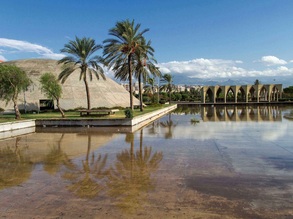- Visit Lebanon

- North Lebanon

- Tripoli (Trablos)
Tripoli (Trablos)

Located 85 kilometers north of Beirut, Tripoli is the country’s second largest city and one of the most traditional places in Lebanon. Predominantly Sunni, it is a friendly and lively place with most remains dating from the Mamluk period. Its name is Greek for ‘three cities’, referring to the three trading areas of Saida, Tyre and Arados that Tripoli used to be part of during Persian times.
Although its first settlement goes back to the 14th century BC, the prosperity of Tripoli started during the Phoenician period in the ninth century BC. Unfortunately, few traces from this period remain. Like Saida and Tyre, its earliest inhabitants were Assyrians, Persians, Greeks, Romans and Byzantines.
Following the destructive earthquake and tidal wave of 551 and the conquest of Tripoli by the Arabs in 635, the city was rebuilt by Justinian I (685-705), who also brought Christianity to the area. In 705, the Arabs re-conquered Tripoli and the city came under Ammar rule starting in 1069. The Crusaders’ influence commenced in 1102, when Raymond de Saint-Gilles erected the Crusader Castle and took full power in 1109, destroying multiple buildings including the famous Dar el-Ilm library. Ruling the Country of Tripoli, the Crusaders rebuilt the city, constructing hospitals, monasteries and churches. Taking over in 1289, the Mamluks destroyed the old port city and massacred most of its population. Under their rule, the city flourished and became famous for its silk factories and glass making. The many souks, hammams, madrasses, mosques and khans date from that time. Tripoli retained its prosperity during Ottoman rule and in 1920, the town came under French Mandate. In 1946, after the French left, Tripoli became the administrative capital of Northern Lebanon. Although it did not suffer as much from the Civil War as Beirut, Tripoli was highly affected by the heavy Syrian bombardments and fighting between Palestinian factions in 1983. The city again lost in popularity during the three-months conflict between the Lebanese army and Fatah al-Islam that took place in one of the Palestinian refugee camps, Nahr al-Bared in 2007.
Now a center for culture and commerce, Tripoli is trying to slowly regain its position, although not without struggle. Contrary to Beirut, traces from the Civil War - especially in the poorer areas - have yet to be erased, with many bullet holes still clearly visible. In addition, the recent (2013 and 2014) severe clashes between (Alawi’ite) supporters and (Sunni) opponents of the Assad regime in Syria in the Bab al-Tabbaneh and Jabal Mohsen area are affecting Tripoli’s stability and reputation. Nevertheless, if turbulence is absent, the old labyrinthine city with its beautiful architecture from the Mamluk era; the impressive, large Crusader Castle; the traditional souqs full of artisans, factories and workshops; and the amazing food make a day in Tripoli definitely worth the experience. Don’t forget to dress appropriately - women should be sure to cover their arms, legs and hair when entering a mosque.
